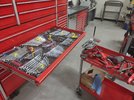I have several sets of ratcheting wrenches and it seems they each have a specific area they have their pros and cons in. I work on a wide variety of items so each time I purchased wrenches I ended up buying an SAE as well as a Metric set. The left side of my toolbox is SAE and the right side is Metric.
In the picture of my wrench drawer below, sets marked #1 were my very first sets I purchased back around 2000. They are Matco with a traditional box on one end and ratcheting on the other. These are awesome wrenches and have been used a lot. I don't flog or beat on my tools so I use the box end to break stubborn fasteners loose and then switch over to the ratcheting end. I have co-workers who have had to warranty a few here and there because they will get too aggressive with the ratcheting end rather than breaking them loose with the fixed end first. These are not what is considered "reversible" in the traditional sense where you flip a lever to change directions. You have to turn the wrench over to change directions as the sprag is not changeable. I have met one instance where this wrench literally got me into a situation where I had to cut the fastener to get out of. Working on a large RV I was running a fastener on and when the nut tightened up, there were so many exposed threads of the bolt that they prevented me from removing the wrench. Rather than let the wrench go with the coach I ended up having to get a die grinder with cut-off disc to cut the threads of the bolt to retrieve my ratcheting wrench. Now I pay close attention to those areas.
Wrench sets labeled #2 are my Snap-on standard length combination open/ratcheting with reverse function and I really like these wrenches. They are "nearly" my go to wrenches with only my standard Snap-on non-ratcheting combination wrenches easily being my "go-to" wrenches. I have had these about 15 year so so. Quality wise these are top shelf and a joy to use. Only had one failure and it was a retaining ring that come off on the 9/16" wrench allowing the center ratcheting part to fall on the shop floor. Upon inspection I could see where I must have gotten it into a bind and the retaining ring walked out. I reinstalled the retaining ring and it has been fine ever since.
Wrench sets labeled #3 are my stubby Gearwrench ratcheting combination wrenches. I use these quite a lot and they have been great wrenches for tight spots. I waffled on these because I really wanted the Snap-on stubbies but was having a hard time justifying the cost. I opted to give the Gearwrench a try and have not been disappointed. I purchased these about 15 years ago at nearly the same time I bought the Snap-on standard length ratcheting wrenches. Similar situations here, I break fasteners loose with either my stubby combination wrenches (Snap-on & MAC) or something else before I go to the stubby ratcheting wrenches to prolong their life and not harm the ratcheting mechanism. I have not experienced any failure of any of these stubby ratcheting wrenches. For the most part a better track record than my Snap-on standard length set.
Wrench sets labeled #4 are the newest to my wrench drawer as I have only had them about 4 years now. I bought these to reach some awkward areas on some FWD cars where I needed to break fasteners loose but space is narrow and limited. Both of these sets are the extended length Gearwrench ratcheting wrenches and I have not used them much at all but I bought them based on the great results I had with the Gearwrench stubby ratcheting wrenches.

I have also had a set of Blackhawk stubby ratcheting wrenches for a short time but did not care for them at all. The teeth didn't seem to have a good feeling engagement and I didn't have confidence in them that they would hold nor last. If I can't trust a tool I don't feel like it belongs in my toolbox so the Blackhawk ones were replaced with the Gearwrench. I know Proto makes the Blackhawk and for the most part I really like my Proto tools but I cannot recommend the Blackhawk ratcheting wrenches.
Mike

